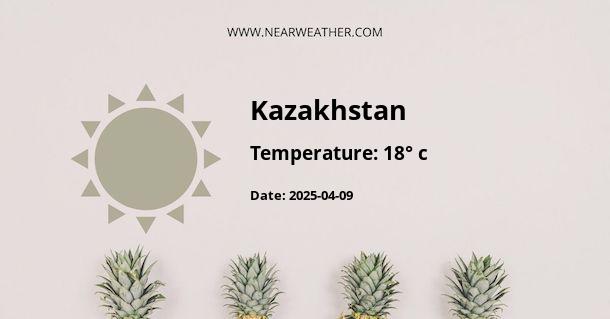Climate and Weather in the Republic of Kazakhstan
The Republic of Kazakhstan, located in Central Asia, is the world's largest landlocked country. With its vast territory spanning over 2.7 million square kilometers, Kazakhstan experiences a diverse range of climates across its various regions. From arid deserts to freezing winters, the country's weather patterns showcase its unique geographical characteristics. Let's explore the climate and weather conditions in the Republic of Kazakhstan throughout the year.
1. Northern Regions
The northern regions of Kazakhstan, including the capital city Nur-Sultan (formerly Astana), have a continental climate characterized by long, cold winters and short, hot summers. Winter temperatures can drop as low as -40°C (-40°F), while summer temperatures can reach up to 35°C (95°F). The region experiences significant temperature fluctuations between day and night throughout the year.
Precipitation in the northern regions is relatively low, with an average annual rainfall of around 300-400 mm (12-16 inches). Most of the precipitation occurs during the summer months, mainly in the form of thunderstorms. Snowfall is common during the winter season, with snow covering the ground for an extended period.
2. Southern Regions
The southern regions of Kazakhstan, including the cities of Almaty and Shymkent, have a more arid and semi-arid climate. Summers in these areas are hot and dry, with temperatures ranging from 25°C to 35°C (77°F to 95°F). Winters are relatively mild, with temperatures averaging between -5°C and 0°C (23°F to 32°F).
The southern regions receive less precipitation compared to the northern regions, with an average annual rainfall of around 200-300 mm (8-12 inches). Most of the precipitation occurs during the spring and autumn seasons. Snowfall is less common in the southern regions, and when it does occur, it usually melts quickly due to the milder winter temperatures.
3. Eastern and Western Regions
The eastern and western regions of Kazakhstan experience a mix of continental and steppe climates. These regions have hot, dry summers and cold winters, with significant temperature variations throughout the year. Temperatures during the summer months range from 25°C to 35°C (77°F to 95°F), while winter temperatures can drop to -30°C (-22°F) or even lower.
Precipitation in the eastern and western regions is relatively low, with an average annual rainfall of around 200-300 mm (8-12 inches). Most of the precipitation occurs during the spring and summer months. Snowfall is common during the winter season, and the snow cover can last for several months.
4. Climate Variations
Due to its vast territory and diverse topography, Kazakhstan experiences regional climate variations. The country's mountainous regions, such as the Tian Shan and Altai Mountains, have a cooler and more alpine climate compared to the lowland areas. These mountainous regions receive higher amounts of precipitation, including significant snowfall during the winter months.
Additionally, the Caspian Sea coastline in western Kazakhstan has a maritime influence, with milder winters and higher humidity compared to the inland areas. The coastal regions experience higher amounts of precipitation, reaching up to 500 mm (20 inches) annually.
5. Extreme Weather Events
Kazakhstan is prone to extreme weather events, including heatwaves, cold waves, and occasional droughts. These events can have significant impacts on agriculture, water resources, and overall infrastructure. The country is also susceptible to dust storms, especially in the arid regions, which can affect air quality and visibility.
It is important to note that Kazakhstan is located in an earthquake-prone region, with occasional seismic activity. However, earthquakes are generally of low to moderate magnitude and do not pose a significant threat to the population.
Conclusion
The Republic of Kazakhstan experiences a diverse range of climates and weather conditions throughout its vast territory. From the cold winters of the northern regions to the hot and dry summers of the southern regions, the country showcases its unique climatic characteristics. Understanding the climate and weather patterns is crucial for residents, travelers, and industries operating in Kazakhstan, as it allows for better preparedness and adaptation to the prevailing conditions.
A - Kazakhstan's Latitude is 48.000000 & Longitude is 68.000000.
A - Weather in Kazakhstan is 4° today.
A - Climate Conditions in Kazakhstan shows overcast clouds today.
A - Humidity in Kazakhstan is 52% today.
A - Wind speed in Kazakhstan is 10.08 km/h, flowing at 291° wind direction. today.
